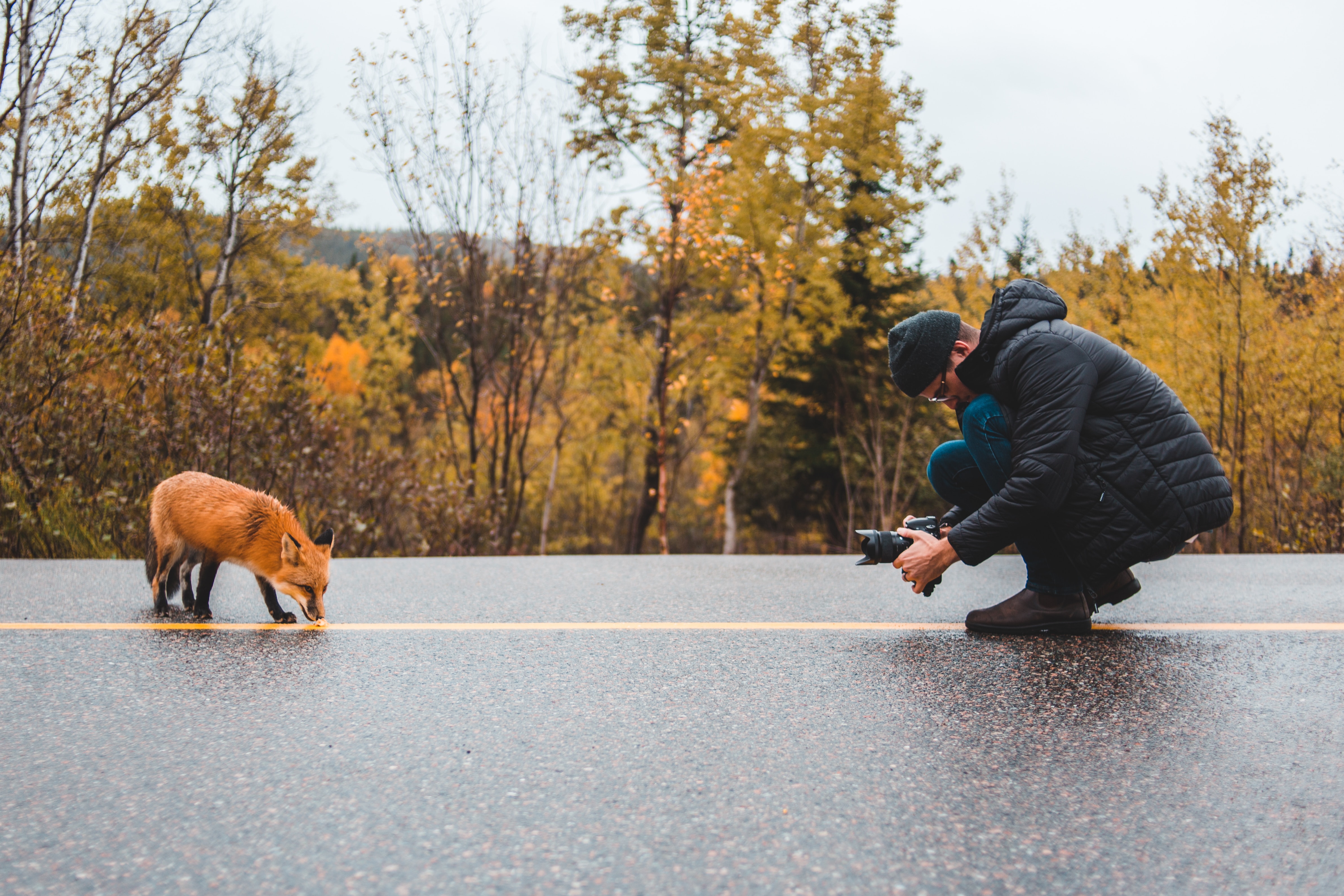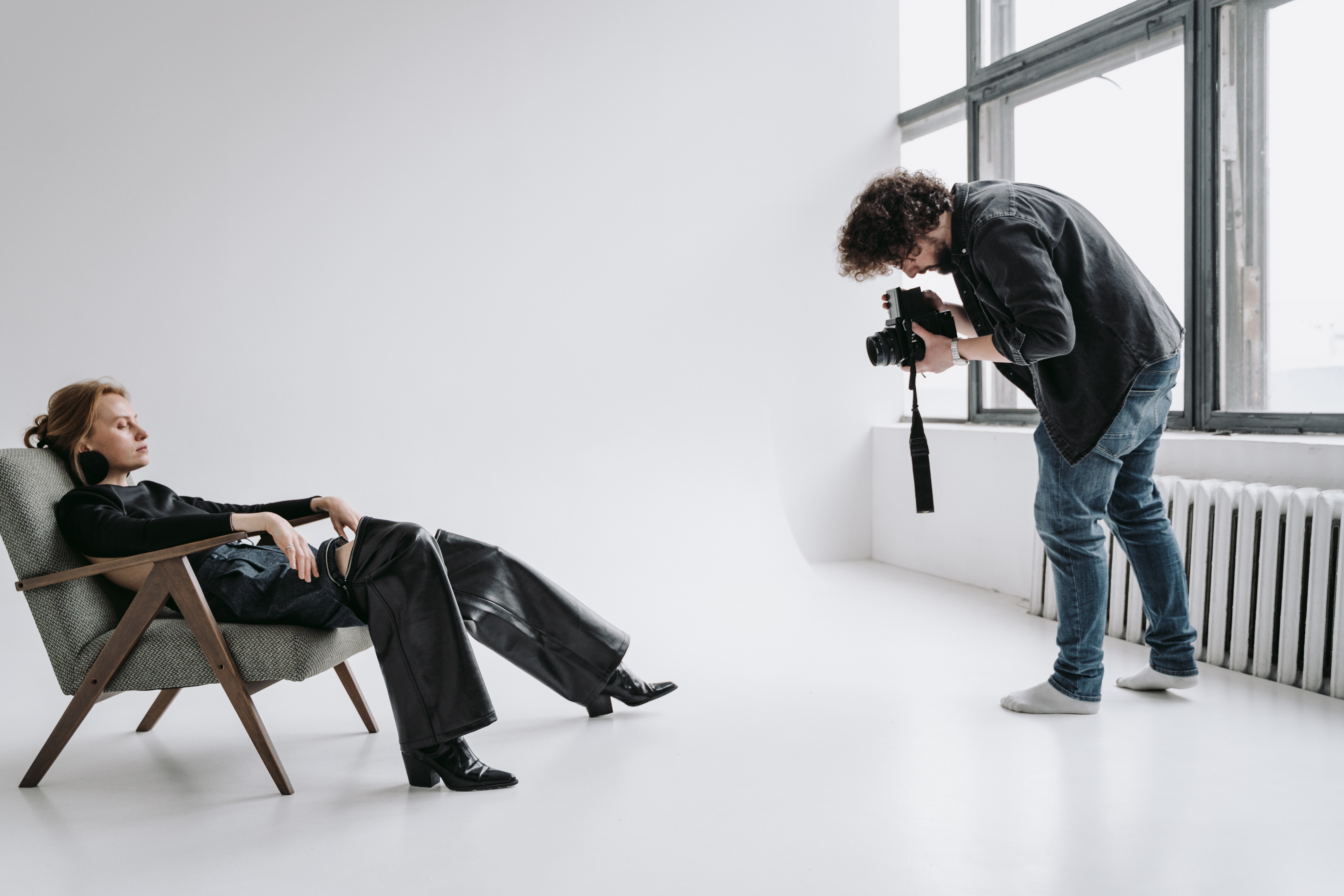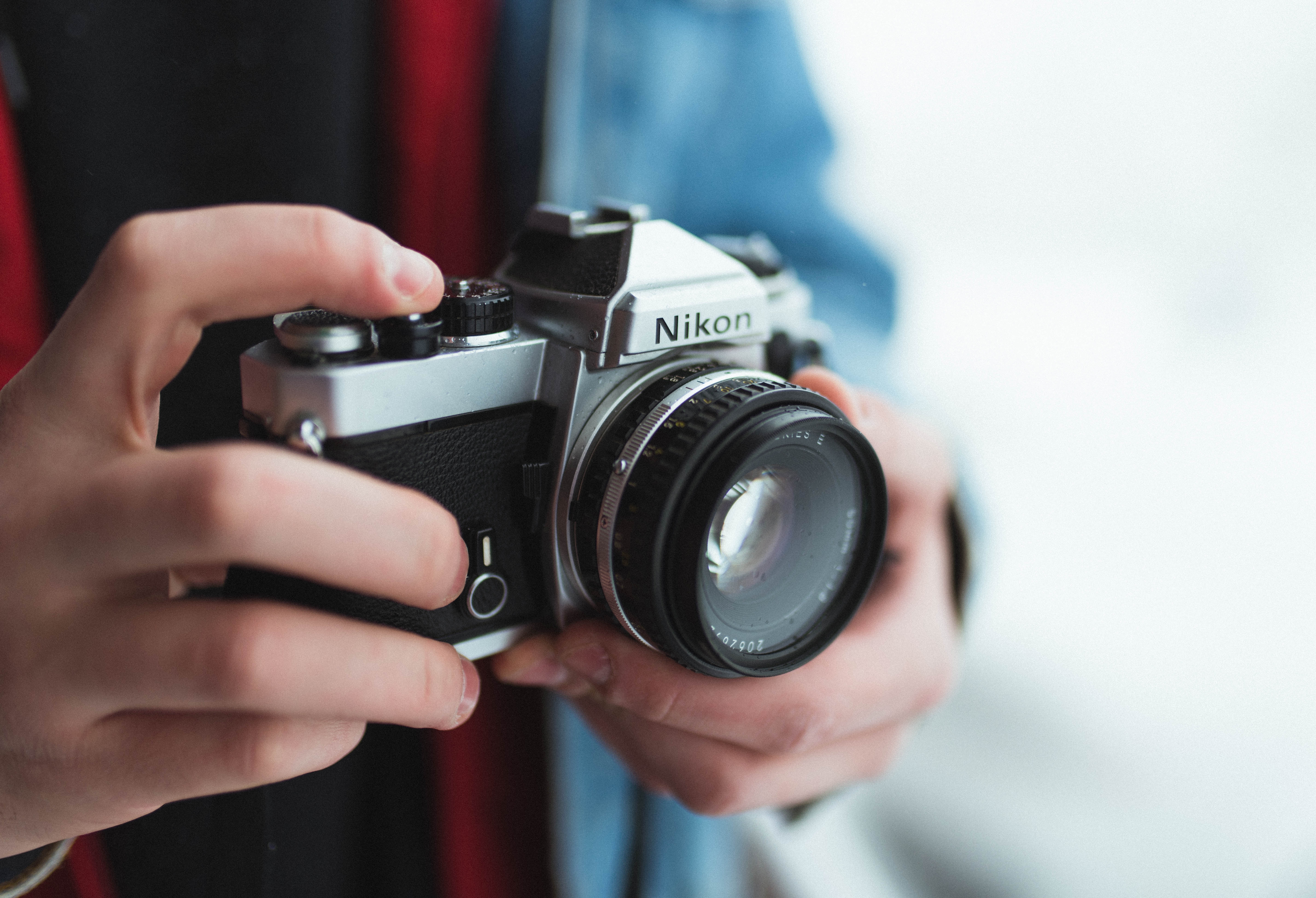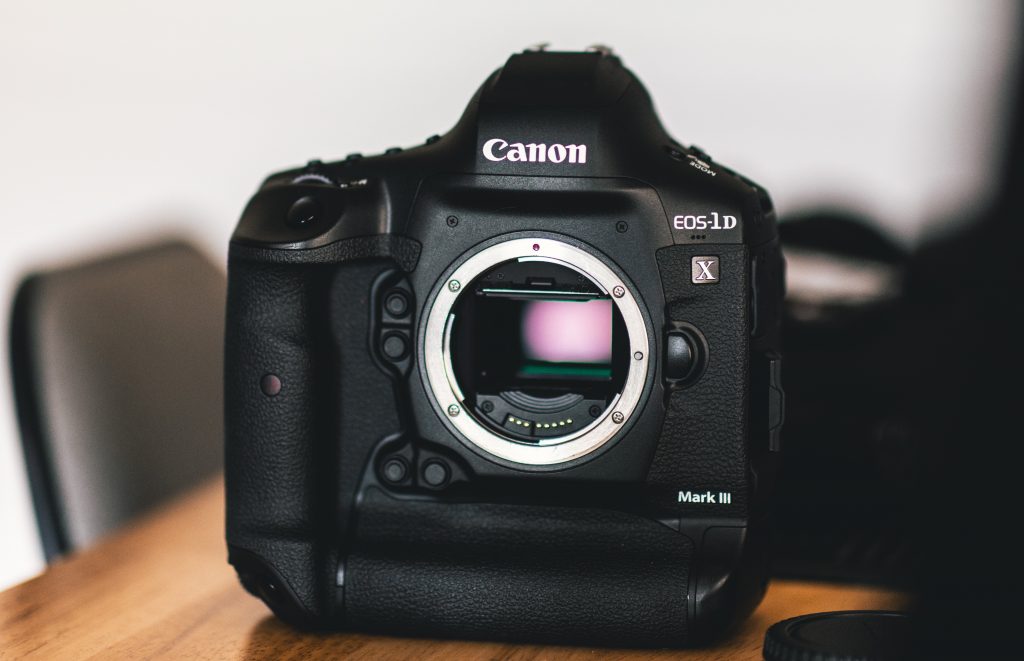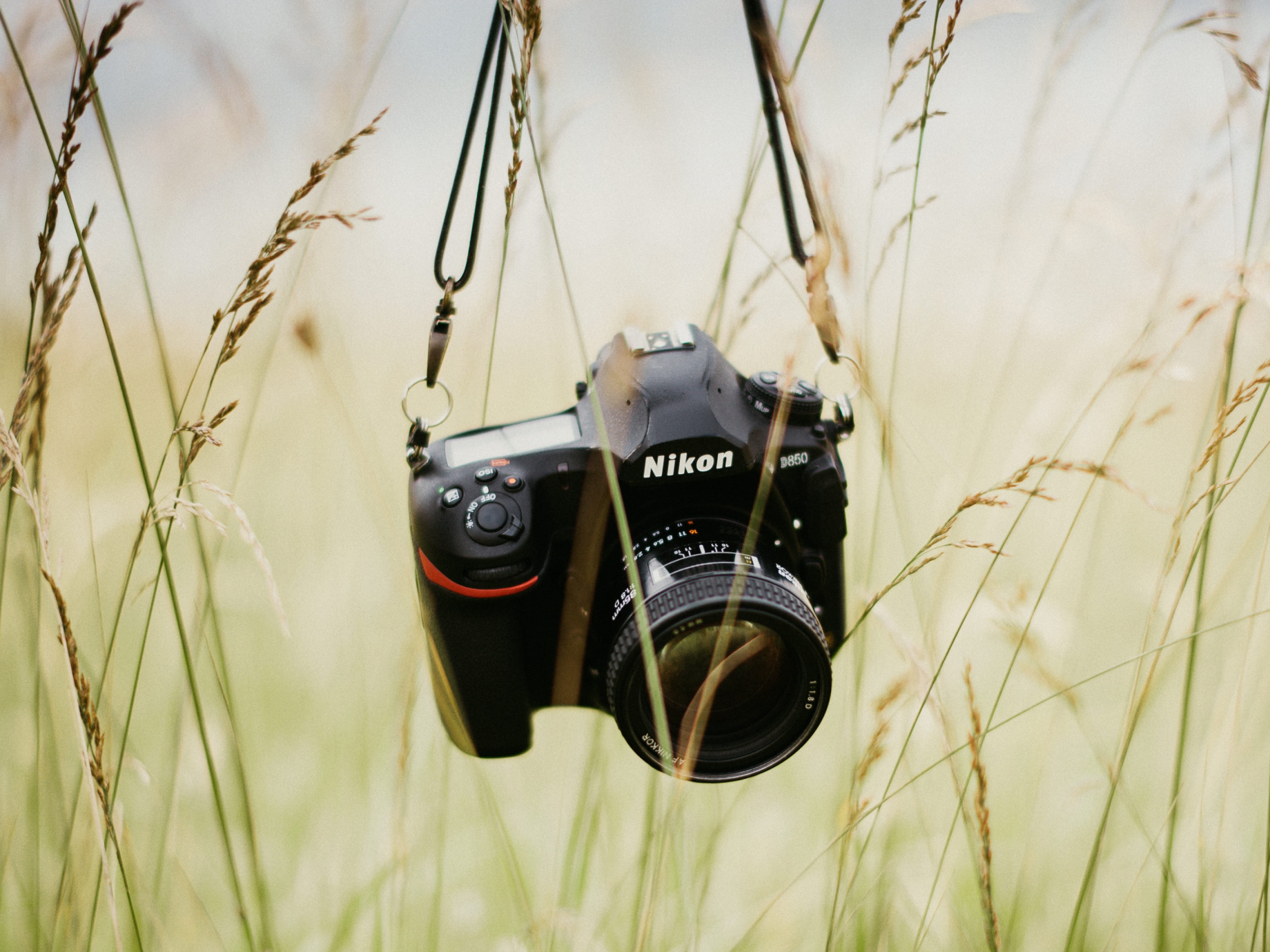
Wedding photographers have an important role in one of the biggest days of a person’s life. There’s a lot of pressure and responsibility that comes with photographing a couple’s wedding day, and for good reason! The photographer is tasked with telling the story of a wedding through impeccable and timeless images that couples will look at for decades to come. This job requires skill, patience, and a camera the photographer can depend on during rapidly-changing moments.
In this article, we’ll explore our top picks for wedding photography cameras and how to make the best choice for you, including:
Things to Consider When Choosing a Camera
Our Top Cameras Picks:
- Canon EOS 5D Mark IV
- Nikon D850
- Canon EOS-1D X Mark II
- Nikon D780
- Sony a7 III
- Fujifilm X-T4
- Canon EOS R6
- Panasonic Lumix S1R
- Nikon Z6
Things to Consider When Choosing a Camera
Wedding photographers have unique concerns when selecting their gear, mainly because capturing the entire event is a tall order, and a photographer’s kit should reflect the significance that comes with that. Here are the features and specifications we focused on when choosing the top cameras.
Camera design trade-offs
Your shooting style and budget may fit a particular type of camera body. Professional wedding photography cameras can be subdivided into three groups based on some of the technology trade-offs engineers must weigh versus market needs.
Cameras optimized for speed and performance:
The toughest and most expensive flagship cameras in most systems from Canon, Nikon, Sony and others are versatile yet built for sports action and photojournalism above all else. These cameras almost always prioritize shooting performance over sheer resolution. That’s not to say these top-of-the-line models don’t have reasonable resolution, but generally there are trade-offs between sensor resolution and image read-out/processing speed. On-sensor autofocus, rolling shutter, frames per second, frame buffer size, heat management, and pixel level noise are some of the many concerns engineers must deal with when making design balance decisions.
If your shooting style leans towards wedding photojournalism, you want to prioritize missing as few moments as possible, and maximum output size isn’t your top concern; thus, these beastly cameras are a natural fit. Strong examples include the: Canon EOS 1DX series, Canon EOS R3, Fujifilm X-H1, Fujifilm X-H2S, Nikon D4, Nikon D5, Nikon D6, Sony A9 series. The Nikon Z9 and Sony A1 are notable renaissance cameras that while optimized for speed still offer resolutions rivaling more studio focused cameras, albeit at price points that more heavily burden budgets.
Cameras optimized for resolution and image quality:
The other main type of professional cameras are higher resolution models typically optimized for image quality over sheer speed. They’re mainstays of studio and landscape photographers as well as many professional wedding photographers. Compared to the speed optimized cameras, these high megapixel professional cams are generally a bit less expensive. Even though they might not be quite as extensively weather sealed as the journo cameras, they tend to have very good build quality. Due to sensor technology trade-offs, they are unavoidably more prone to “rolling shutter” effects but can often shoot at very acceptable frame rates at least for bursts. Autofocus hardware on leading high resolution pro cams is usually derived from sports models too; the AF tracking performance is unlikely to be fully on the same level as a sports camera from the same generation, but it’s generally fine for the pace of most wedding work. Sharp examples include the: Canon EOS 5D Mark IV, Canon EOS 5D Mark III, Canon EOS R5, Fuji GFX series medium format cameras, Fujifilm X-H2, Nikon D850, Nikon D810, Nikon Z7 series, Panasonic S1R, and Sony A7R series.
Cameras optimized for the most popular features and value:
Many pros carry another type of camera that may not be the undisputed champion in any area other than the extra space they make in your budget for the other gear you need to deliver the goods. Sometimes these are called prosumer cameras, or a pro-back-up camera, or a “goldilocks” camera, or perhaps just “a good camera.” Whatever the name, it’s often the case that a photographer wants a feature rich camera with decent resolution and image quality but being on the cutting edge for shooting speed isn’t what matters as much as having the budget for that portrait lens. Good examples include: Canon EOS 6D, Canon EOS 6D Mark II, Canon EOS R6 series, Fujifilm X-T4, Nikon D780, Nikon D750, Nikon Z6 Series, Panasonic S1, Panasonic S5, and Sony a7 series.
So, what style of camera is right for you? Well unless you are adamant about having identical sets of controls, many shooters mix and match the styles above. Maybe you choose a tank of a sports camera to counter-balance your 70-200mm zoom while using a higher res model for wide-angle and group photography. If you’re just starting out, consider if it makes more sense to get two identical cameras that are good but allow you to afford a better lens and lighting kit.
Image quality
Image quality in particular is a top factor. First, because weddings are a memorable day in a couple’s life, they will expect their photos to be sharp and clear to reflect that importance. Next, many couples will opt to print their images in larger format to frame in their homes or create heirloom albums, so the images need to be high-resolution enough as to not produce grain or distortion when printing.
Most photographers will opt to invest in a camera with a high-resolution full-frame sensor (between 20-50 megapixels) in order to provide higher-quality images to clients. When other factors are equal, full-frame sensors make it easier to create a shallower depth of field than APS-C (cropped) sensors. Full-frame sensors also tend to produce cleaner images with less overall noise than APS-C (cropped) sensors at the same settings, particularly when shooting in low-light when you might need to use a high ISO. But that’s not to say you can’t find an incredible cropped sensor with all the features you need, too.
Low-light performance
Photographers are often shooting weddings in venues with little to no natural light such as churches, restaurants, hotels, and more. Though flash is an option for the reception and post-ceremony activities, some couples prefer that the photographer not use flash during the ceremony to preserve the experience for themselves and their guests. As such, it’s important to have a camera with outstanding low-light capabilities.
There are a few features we looked for that make some cameras better in low-light situations than others in their category such as sensor size (full-frame sensors tend to perform best), wider ISO ranges, and megapixels. Lens aperture is also a factor, which we will get into more below.
Autofocus system
Weddings are packed with important moments that happen extremely quickly, so you need an autofocus (AF) system that is fast, reliable, and accurate. Wedding photographers may want to look for cameras that offer an AF system to detect and track the eyes or faces of their subjects even while they move, or offer machine learning to improve autofocus over time, like Canon offers in some of its more current models that utilize Dual Pixel CMOS AF II. This type of lock-on AF tracking technology allows you to spend less time toggling buttons in order to keep their subjects in focus on a fast-paced day.
Low light autofocus can also be an important consideration. Some cameras are able to autofocus in lower ambient lighting than others; it’s common for pro camera manufacturers to publish specs that include the lowest EV (Exposure Value) a camera needs for autofocusing in ambient light. Lens brightness and AF motor speed also play a major role in low light capabilities.
Speed and burst rate
Weddings are generally on tight timelines and move rapidly, which means photographers need to capture essential moments as they happen, like the first kiss and the bride walking down the aisle. Because of this, you’ll want to opt for a camera that offers ultra-fast shutter speeds and a burst rate above 7 fps (frames per second) so they can capture everything at a moment’s notice. In addition to a higher burst rate, a larger image buffer and compatibility with fast writing memory cards are also suggested to help avoid your camera locking up in a critical situation while it attempts to clear the buffer and write the images to the card.
Size and weight
Weddings are some of the longest working days any photographer may experience, ranging from 8-10 hours of coverage, while others are a multi-day event. Many photographers will use two different camera bodies with different lens focal lengths on each day so they aren’t wasting precious time swapping out lenses while the action is happening.
Since you’ll often be carrying around so much gear, you should look for bodies and lenses that are more compact and easier to lug around all day without causing discomfort. When it comes to size and weight, some photographers have switched to mirrorless camera systems, which are generally smaller and easier to cart around on a 10-hour wedding day. While others who prefer DSLR will opt for smaller and lighter digital bodies and lens options.
The flip side of this advice is that many photographers will forgive extra weight for a drastic increase in battery life as that allows them to worry less about battery management and focus on capturing every moment of the special day. Thus, we see many photographers utilizing cameras like the Canon 1DX line or Nikon D5/6. Even if shooting mirrorless, quite a few photographers will attach a battery grip for that extra battery life assurance and the ability to utilize a second shutter button on that grip in the portrait orientation to help save their wrists. This exchange is where you see a massive benefit from a multi-camera shoulder harness to relieve some of that weight.
Price
While you can find a great camera for a reasonable price, one thing to keep in mind as a professional wedding photographer is that when investing in a more expensive camera body, you’re oftentimes paying for improved technology and features that some older models won’t have. That being said, you don’t have to pay full price to get the quality you want! KEH offers high quality used camera gear at great prices.
DSLR or Mirrorless?
The battle between mirrorless and DSLR has been a somewhat polarizing topic for many professional photographers over the years, with each system having its advantages and disadvantages. Many who prioritize comfort and camera size have switched to mirrorless cameras because they tend to be lighter and smaller to carry around during a long day. Other photographers will choose a DSLR camera due to its durability and often superior battery life, which is important when shooting long days consecutively.
In the end, the choice between DSLR or mirrorless will come down to personal preferences including what types of weddings you shoot and what features you look for in a camera.
Now without further ado, here are our favorite picks for the best wedding photography cameras (both mirrorless and DSLR options)!

1. Canon EOS 5D Mark IV – $1,500 for body only
Type: DSLR
Our frontrunner is the Canon EOS 5D Mark IV. This camera boasts a 30.4 mp full-frame CMOS sensor for extremely sharp portraits, a burst rate of up to 7.0 frames per second, and a 61-point phase detection autofocus system making it an all-around powerhouse. With the 5D Mark IV, Canon incorporated its dual pixel focusing technology allowing incredibly fast and accurate 100% frame coverage while using live view.
This model also offers cropped 1.74x 4K video recording, in-camera wi-fi, and great low-light performance, with the ability to crank ISO up to 6,400-12,800 without any overwhelming or significant noise or distortion for things like sparkler exits, sunset cocktail hours, etc. (Note: The 5D Mark IV will have a decent helping of color noise past ISO 3,200 and by 12,800 is hardly usable.)
Another great feature is the dual memory card slots, allowing photographers more flexibility with storage and memory.
Pros: Lots of features at a great price; great battery life (900 shots per charge)
Cons: One of the older models here (came out in 2016) but makes it so you can get it at a great deal!

2. Nikon D850 – $2,000 for body only
Type: DSLR
Another DSLR pick for our top wedding cameras is the Nikon D850. The D850 offers a massive 45.7 megapixel full-frame sensor, creating extremely high-resolution photos and allowing you to get incredibly sharp and detailed portraits and action shots throughout.
This camera also offers 4K video shooting up to 30 fps, an impressive continuous shooting frame rate of 9 fps, tilting touchscreen, and focus shift shooting mode making it a strong contender for nearly every type of wedding photographer. And it’s weather sealed, giving you peace of mind should you have to shoot in rain or snow.
Pros: Incredibly high resolution and dynamic range makes for amazing images at any wedding; users love the battery life.
Cons: No dual SD card slots; a bit heavier than mirrorless competitors; less flexibility in low light/high ISO due to higher megapixel count and subsequent decline in photosite size due to more photosites being on the sensor.

3. Canon EOS-1D X Mark II – $2,000 for body only
Type: DSLR
The Canon EOS 1DX Mark II was designed for speed, responsiveness, dependability, and versatility. It has a 20.2 mp full-frame sensor and an impressive burst rate of 14 fps at full resolution, making it one of the fastest cameras on this list and ensuring that no wedding photographer will miss a moment of the action! Other prominent features include an ISO range of 100–51,200 (expandable up to ISO 409,600), an easy-to-use 3.2-inch touchscreen, and cropped 1.34x 4K video shooting.
The 1DX Mark II was also the first full-frame Canon EOS to feature the dual pixel autofocus (mentioned above), which delivers improved focus tracking options the more the camera is used. The speed and accuracy of the autofocus makes it an enticing camera for any photographer who needs to be able to capture important moments quickly and efficiently.
This camera also offers an extended battery life due to the high LP-19 batteries in the built-in battery grip.
Pros: Extremely fast shooting and “smart” autofocus
Cons: Price point is higher than some of the others on the list, but the specifications warrant that pricing

4. Nikon D780 – $1,800 for body only
Type: DSLR
The Nikon D780 is another great full-frame DSLR for those not needing D850 level resolution. It offers all the features a wedding photographer could hope for including 24.5 megapixels, dual SD card slots, exceptional low-light shooting, great battery life, and a more rugged design for long-lasting use.
The D780 also boasts fast and accurate autofocus in live view and continuous burst speeds up to 12 fps, which makes it a top contender on any wedding photographer’s wish list. The traditional design may attract those who seek out a more comfortable grip and solid design and the RAW compressed feature makes for space-saving storage when shooting long wedding days.
Pros: Impressive all-around features make it a powerful workhorse
Cons: More expensive than others on this list since it is a newer model

5. Sony a7 III – $1,400 for body only
Type: Mirrorless
Sony remains at the forefront of mirrorless camera technology. Though this model is from their “mid-range” line and was released in 2018, it comes with the features most beginners in professional wedding photography want. The a7 III has a 24 mp full-frame sensor, dual card slots, 4K video, tilting touchscreen, and great battery life all at an affordable price. The 24 megapixel sensor is a great choice for weddings because it provides enough resolution for crisp images without taking up a ton of space on your harddrive. This model also has in-body image stabilization and shoots with continuous burst speeds up to 10 frames per second–a noteworthy feature for a camera at its price point.
And for wedding photographers who may also provide video services, the Sony a7 III shoots in 4K full-frame video, which is some of the best in its class. Because it’s a mirrorless camera, it is lighter and more compact than others on the list, while also providing a weather-sealed body for outdoor weddings.
This model has a wide array of great lenses from both Sony and third-party companies for the EF mount, allowing for more flexibility when looking for the best prime and zoom lenses.
Pros: A wide range of desirable features at an affordable price: 10fps, eye detection, uhd video, good connectivity
Cons: Mechanical shutter could be quieter; lower megapixels compared to other models on this list

6. Fujifilm X-T4 – $1,400 for body only
Type: Mirrorless
Another mirrorless option and one of the newer cameras on our list, the Fujifilm X-T4 was released in 2020 with great anticipation from those looking for a great camera from Fujifim’s flagship mirrorless lineup. The X-T4 has a 26.1 mp APS-C sensor, creating ultra-sharp images even with the cropped sensor. It also offers improved battery life and in-body image stabilization, which is huge for photographers who are constantly moving around or wanting to be able to shoot video or use longer exposures during the wedding.
Another feature that makes this model a massive contender on this list is the ability to shoot unbelievable burst speeds of up to 20 fps with the mechanical shutter and 30 fps with the electronic shutter, which is one of the best we’ve seen. This ensures you will never miss a dance-floor action shot again!
The X-T4 also offers some of the best weather sealing, making it a truly durable and sturdy option for those who regularly shoot outdoor weddings.
Unlike the earlier Fujifilm X-T series cameras, the X-T4 features a side swivel LCD monitor as a more versatile design for hybrid wedding videographers.
Pros: IBIS (In-Body Image Stabilization); extremely fast burst rates; great price
Cons: Cropped sensor may be a deal breaker for photographers loyal to full-frame cameras

7. Canon EOS R6 – $2,000 for body only
Type: Mirrorless
From Canon’s mid-range mirrorless line comes the R6, which has a full-frame 20 mp sensor, dual memory card slots, great autofocus, and impressive low-light capabilities, making it a solid choice for any photographer wanting to capture gorgeous wedding images. And while 20 megapixels may seem low compared to others on the list, it does make for more manageable file loads when thinking about shooting, culling, and editing thousands of images from a full-day wedding. In addition, it offers more flexibility in lower light and higher ISO’s due to the lower mp count.
The R6’s autofocus is the same found in the higher-end R5, which utilizes machine learning to improve subject tracking with continued use, making it one of the best autofocus systems around for tracking wedding subjects quickly and reliably. It can also autofocus in light conditions down to EV -6.5.
Similarly to Canon’s DSLR line, the R6 has a durable build quality, yet is much lighter than its digital counterparts, which is a plus for those looking to scale back the amount of weight they carry on a busy day.
Pros: Great expandable ISO range for great low-light performance; fast; excellent image quality even though it’s not the highest resolution option
Cons: While the R6 is a great deal, there is a newer version (R6 Mark II) available that may be enticing for some

8. Panasonic Lumix S1R – $2,000 for body only
Type: Mirrorless
While some photographers flock to brands like Canon, Nikon and Sony, many took notice when Panasonic made waves with the release of the Lumix S1R mirrorless camera. The S1R has a massive 47.3 megapixel full-frame CMOS sensor, making it a beast when it comes to capturing ultra high-resolution images for your couples on their big day.
Other notable features are dual SD card slots, dual image stabilization, 4K video capabilities, and 225 contrast-detection autofocus points.
The build of the S1R is also a draw for photographers who prefer the feel of a DSLR body as it mimics the style of a DSLR with a larger handgrip and more of physical controls. It really shines in low-light situations with a native ISO range of 100-25,600 (expandable to 50 and up to 51,200), making it a great choice for those who routinely shoot indoor weddings.
Pros: Superb EVF (Electronic Viewfinder); high resolution; great features
Cons: File sizes for larger weddings may be a deterrent for some; higher price point than others in the category

9. Nikon Z6 – $1,200 for body only
Type: Mirrorless
Though Nikon is newer to the mirrorless space than competitors like Sony, the Z6 is as capable and packed with as many features as any model in its category, especially at the price point. With a 24.5 mp full-frame sensor, 12 fps burst shooting, super fast autofocus system with 273 phase-detection points, and an ISO range of 100-51,200 (expandable to 204,800), the Z6 holds its own against mirrorless competitors, especially for Nikon-loyal photographers who want to move to a mirrorless system and potentially adapt their Nikon F-mount glass.
These features, along with the ability to shoot 4K video, make it a great choice for wedding photographers who need knockout features at an affordable price.
Pros: Incredible low-light performance; great price
Cons: Single SD card slot; the tilting screen is a bit awkward
Other Important Gear
Lenses
Picking lenses for a wedding can be a make-or-break situation. Though lens choices can vary from photographer to photographer based on preferences, there are a few lenses that many agree on. You likely will want to opt for longer focal lengths during a ceremony so you are able to stand further back from the couples and the guests while still capturing those sentimental moments. Most wedding photographers will keep a mix of prime and zoom lenses in their kit to account for different parts of the event, including the ceremony, portraits, and the reception.
Prime lenses: Our go-to lenses for ceremonies are an 85mm, a 135mm, and a 50mm. The 85mm and 135mm options allow one to stand in the back or to the side without blocking the view of guests while also getting up-close moments like putting on the rings or the first kiss. For portraits, we love a 35mm and 85mm combination for crisp subjects and more depth of field. That being said, a fast aperture 50mm option is often the most versatile and used by many photographers on a wedding day.
Zoom lenses: Some photographers will shoot on one prime lens and have a zoom lens on their second camera body, like a 70-200 for the ceremony. And for the reception, you may like to slim down to just one camera body and shoot on a more versatile lens like a 24-70mm, or a 16-35mm to capture those all-important dance floor moments, even in tight spaces.
Another consideration when it comes to lenses is the aperture range. Typical ranges of apertures used in photography are about f/2.8–f/22 or f/2–f/16, covering six f/stops. Wedding photographers who shoot mainly indoor weddings may want to opt for lenses with lower apertures available like f/1.8, f/1.4, or even f/1.2, which would allow more light into the camera sensor without increasing your ISO.
Lighting
Another gear consideration for wedding photographers is having additional lighting sources. If you’ll be shooting larger indoor weddings with little to no natural light, you’ll likely want to invest in both on and off-camera flash as well as a few standing lights to improve the amount of light you have to work with during the event. Types of notable lighting options:
- Speedlights are a type of small flash that attach to the camera and provide lighting to your subjects. Speedlights are a relatively affordable way to light your subjects at receptions or indoor weddings.
- Note: we recommend using a flash diffuser to soften the light a bit and reduce hard shadows. You can also utilize the bounce card that comes attached to most speed lights and angle the flash appropriately.
- Strobe lights are a type of flash lighting that dominate the world of studio lighting. When we talk about studio lights, we’re often thinking about strobe lights.
- Continuous lights (otherwise known as hot lights) for photography don’t “flash” but instead remain stationary and provide a continuous lighting source in darker environments. We’d also recommend adding a softbox, which provides even and diffused light. One downfall with continuous lights is that they can be difficult to accurately “match” the other ambient lighting in the space.
Tripods and monopods
If you’re shooting video or want to be able to effectively shoot in two places at once, you may want to invest in a high-quality tripod. Some photographers will set up a stationary camera to shoot video of the wedding ceremony, while others will use a tripod to grab another angle of photography (using internal shooting) while also moving around and shooting on another camera body and lens.
If you don’t have a second photographer helping to grab these important moments from different angles, a tripod can help you achieve a similar effect.
Memory cards
Wedding photographers know that having multiple memory cards for any wedding is essential. And not only do you need multiple memory cards to capture the day but you also need ones with the ability to write images quickly and efficiently.
Another item that is imperative to bring along, especially for a traveling wedding photographer, is a portable memory card reader so you can quickly import all your images onto your harddrive or your external harddrive so nothing gets lost.
Backup equipment
Many photographers will opt to carry multiple camera bodies and lenses not just for versatility and flexibility but also in case one of their cameras or lenses fails. Having a backup camera setup in case of a worst-case scenario is imperative for anyone tasked with capturing one of the most important days in someone’s life. When budgeting for your camera kit, consider whether having identical control layouts is important to you.
Building Your Wedding Photography Kit
Whether you’re a beginner or a professional, wedding photography is not for the faint of heart. And while the camera, lenses, and additional gear don’t necessarily “make” the photographer, these choices can make the overall experience easier and more streamlined for both the photographer and the couple. At the end of the day, you need to have a fast and reliable camera with a long list of noteworthy technology features that will allow you to provide both incredible photos and a memorable wedding day for your clients.
But remember, high-quality camera gear doesn’t need to break the bank. Many wedding photographers–myself included–will choose to build up their wedding photography kit through first-rate used gear from a reputable seller like KEH.

